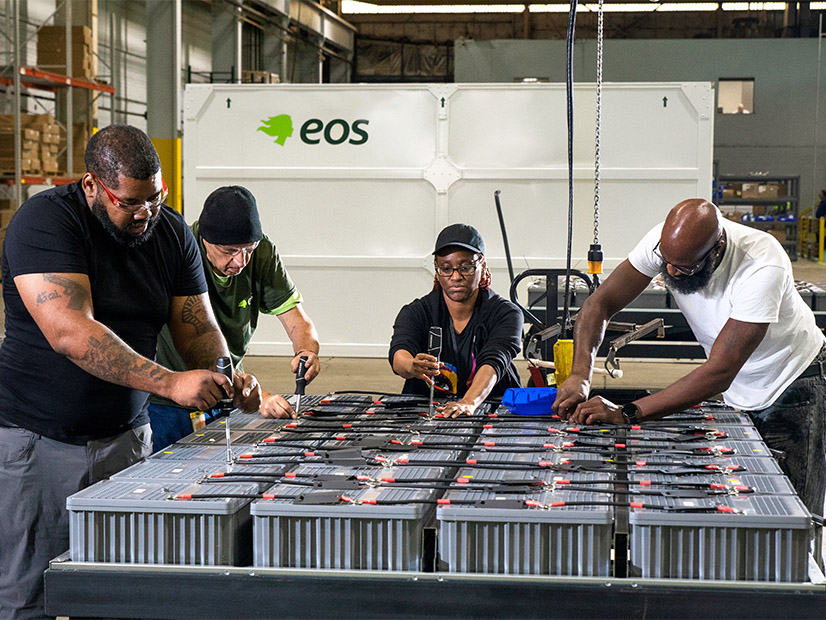Dominion Energy on Monday asked Virginia’s State Corporation Commission (SCC) to approve a long-duration energy storage pilot project that it said would greatly increase the amount of time batteries can discharge power to the grid.
The utility wants to install two storage facilities at its Darbytown Power Station, a natural gas plant in Richmond. One will test zinc-hybrid batteries from Eos Energy Enterprises, and the other will test iron-air batteries developed by Form Energy that can discharge for up to 100 hours, compared to the average of just four hours for most standard lithium batteries on the market.
“We are making the grid increasingly clean in Virginia with historic investments in offshore wind and solar,” Dominion Energy Virginia President Ed Baine said in a statement. “With longer-duration batteries in the mix, this project could be a transformational step forward, helping us safely discharge stored energy when it is needed most by our customers.”
The SCC needs to approve the project, as does Henrico County. If approved on time, construction would start by late next year, and the two battery systems would be operational by late 2026.
Virginia’s Grid Transformation and Security Act of 2018 directed the development of battery storage pilot programs. Dominion has built three already in other parts of the state and has another three under development.
The proposal comes as Dominion is working to develop the largest offshore wind project in the country and continues to expand the second-largest fleet of solar panels in the country.
The batteries are meant to help improve the integration of renewable resources and cut the need for additional generation during times of high demand. Dominion also is seeking approval of two other battery projects; if the SCC authorizes them all, it will have 28.34 MW of batteries on its system, compared to 16 MW now.
Dominion evaluated proposals from more than 30 companies and picked Eos and Form because they have paths to commercial viability, as well as safety, the supply chain, efficiency and support from investors, it told the SCC.
Form’s iron-air battery is a 4.94-MW/494-MWh AC multiday system, while Eos’ zinc-hybrid is 4 MW/16 MWh.
“These technologies are expected to have lower thermal runaway risks than lithium-ion energy storage currently presents,” Dominion said in its application. “Additionally, recent history has shown significant pricing volatility and supply chain constraints for lithium-ion battery materials that could cause limits to the energy storage buildout plans.”
Competition for the raw materials for lithium-ion batteries with the vehicle market is getting increasingly fierce, which will significantly increase price volatility. The grid also is going to need long-duration energy storage to help balance the growing share of intermittent resources, Dominion said.
The Form system is made up of 128, 37-foot containers, while Eos’ is made up of 39, 17-foot containers. The two facilities also will require about 10 inverters and two transformers. Despite covering a total of 435,600 square feet, Dominion said the project will be largely hidden from neighbors on the existing plant’s site, so it does not present any environmental justice issues.
Form’s battery is made of iron, water and air. It works by using “reversible rusting.” While discharging, it takes in oxygen from the air and converts metal iron to rust, and while charging, the application of an electrical current converts the rust back to iron, and oxygen is released.
“We are pleased to partner with Dominion Energy on the innovative Darbytown Storage Pilot Project and look forward to delivering a 100-hour iron-air battery system that will enhance grid reliability and provide Dominion’s Virginia customers with access to wind and solar energy when and where it is needed over periods of multiple days,” Form CEO Mateo Jaramillo said.
Eos’ system can operate in three- to 12-hour discharge configurations. During charge and discharge, ions move through electrolytes to their respective electrodes to donate or accept electrons, creating a current flow through the battery’s bipolar stack.
“We are proud to have been selected for this critical project. Dominion understands that meeting our future energy needs requires multiple storage technologies,” Eos CEO Joe Mastrangelo said. “We’re excited to show Dominion how well our zinc-hybrid batteries perform.”
Dominion is asking to spend about $70.6 million on the project. That works out to $7,897/kW, which is a premium compared to the $1,325/kW standard batteries cost, according to U.S. Energy Information Administration data used in its 2022 Annual Energy Outlook, the agency’s most recent.


